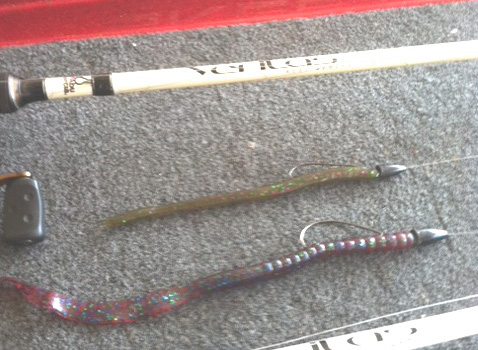
Multiple choices and presentation options make it a consistent dynamite producer
EDITOR’S NOTE: When it comes to targeting bass at Toledo Bend, Joe Joslin enjoys using a wide variety of baits, but his favorite method of fishing is with a Texas rig. A tournament angler and pro guide on both Toledo Bend and Sam Rayburn, Joe shares some of his bass-fishing insights and explains his love for the Texas rig in this article he penned below.
As a guide I am asked a lot of questions about boats, electronics, various lakes, the latest tackle and many other topics that anglers deal with on a regular basis.
People regularly ask me about my all-time favorite bait, and wonder about my favorite way to catch bass.
The truth is, I don’t have a single-favorite way to catch fish: I love topwater, wacky worms, jigs, spinnerbaits, drop shot, jigging spoons and crankbaits, just to name a few.
But if I could only have one method to fish, that’s easy… I’d pick the Texas rig, hands down.
With a Texas rig, you can fish in 6 inches of water or 40 feet of water, and you can use finesse worms or 10- and 12-inch worms. You can fish them weightless, or with a heavy sinker of an ounce or more.
I pick the Texas rig because we’ve just caught so many bass on them through the years, and it’s once again been a dynamite producer for us in 2013.
It’s versatile, too: you can fish it in all kinds of structure and cover, and it shines in deep grass and the scattered Hydrilla that’s abundant in south Toledo.
Anglers have the choice of a straight-tail worm, split-tail or one with a swimming tail, and multiple presentations are possible.
Most anglers have a few closely-guarded secrets, and some of those are how we work various lures.
Correct presentation is vital, nowhere more so than when fishing the clear water of the heavily-fished bass at Toledo Bend. One of the most significant recent improvements in fishing a Texas rig in clear conditions is the improved technology in fishing line, mainly fluorocarbon.
I basically wouldn’t even consider fishing a Texas rig without using fluorocarbon. There are a few high-quality fluorocarbon lines available today, but my favorite is Berkley Pro Grade Trilene 100% fluorocarbon.
I use 17- and 15-pound test most of the time, but also use 10- and 12-pound as well. When using fluorocarbon line with a Texas rig, you have the advantage of it being totally transparent with almost no stretch, for a solid hook set and improved sensitivity to feel the lightest bite.
It’s also extremely abrasion-resistant and super stong. Once you start using it, monofilament on a worm rig just won’t cut it.
One reminder: fluorocarbon sinks so it does not work on topwater applications, or any method where you want your bait to float. However, it also works really well on swimbaits, jerkbaits and crankbaits.
Finally, the Texas rig is one of the best techniques for fishing heavy brush.
There’s just nothing quite as exciting as crawling a Texas-rigged 10-inch Berkley Power Worm through a deep brush pile, feeling the bite and then setting the hook on a monster largemouth.
Of course, there are numerous other ways to fish a Texas rig, probably enough to write an entire book.
I will say that one of my my most productive methods the past few months has been Texas-rigging Berkley’s Havoc Bottom Hopper and Trick Worms, and easing them through the outside edges of south Toledo’s Hydrilla in 16- to 24- feet of water. Just remember to work it slow with pauses.


